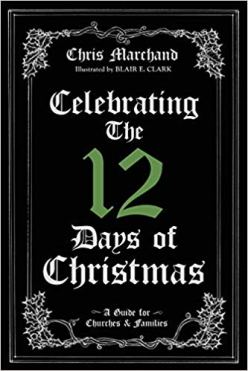 It’s a bit of a cliché to observe that the Christmas season seems to be growing longer and longer each year, slowly edging its way into store displays and advertisements before the cold air of winter has even arrived to make heavy jackets truly necessary. Readers of Celebrating the 12 Days of Christmas soon discover, though, that for the Chris Marchand, the problem is more that the very idea of Christmas as a season has fallen by the wayside—a liturgical season, that is. Marchand, an Anglican minister and writer (among other things), has penned this book in order to both delve into the varied traditions of the liturgical season and its feast days and to foster the revival of its celebration by offering readers suggestions for renewing the practices of old in ways that make sense for today. Continue reading
It’s a bit of a cliché to observe that the Christmas season seems to be growing longer and longer each year, slowly edging its way into store displays and advertisements before the cold air of winter has even arrived to make heavy jackets truly necessary. Readers of Celebrating the 12 Days of Christmas soon discover, though, that for the Chris Marchand, the problem is more that the very idea of Christmas as a season has fallen by the wayside—a liturgical season, that is. Marchand, an Anglican minister and writer (among other things), has penned this book in order to both delve into the varied traditions of the liturgical season and its feast days and to foster the revival of its celebration by offering readers suggestions for renewing the practices of old in ways that make sense for today. Continue reading
Henri, Vincent, and Living in the World with Kindness: A Review of Carol Berry’s “Learning from Henri Nouwen and Vincent van Gogh
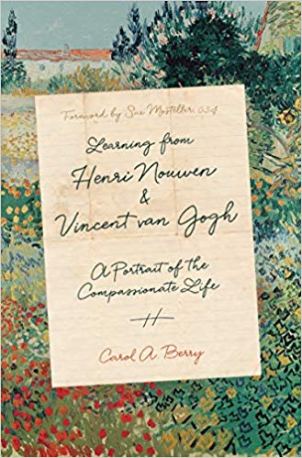 *This review was originally published over at The Englewood Review of Books. If you have a few minutes, please go check out some of their other reviews.
*This review was originally published over at The Englewood Review of Books. If you have a few minutes, please go check out some of their other reviews.
Carol A. Berry first met Henri Nouwen in the bookstore at Yale Divinity School back in the 1970’s. As she recounts in her moving (and brief) book, Learning from Henri Nouwen & Vincent van Gogh, he initially appeared like “a man dressed in a well-worn, baggy, moth-eaten sweater with a woolen scarf around his neck” (4). Though Nouwen may have looked like a disheveled, older student, he was actually teaching at Yale at the time, and Berry was deeply moved while sitting in on Nouwen’s lecture on Vincent van Gogh and the nature of the compassionate life. Nouwen is known by many as a deeply kind Catholic spiritual writer, and for me, his writings—and especially letters—have been a real gift. Nouwen felt a deep connection with van Gogh as a fellow wounded healer who desired to connect with other and provide them with comfort, and he worked hard to share this connection with his students (8). As Berry puts it, the hope was that, “Through Vincent’s story, through the parable of his life, we were to come closer to an understanding of what it meant to be a consoling presence” (52). Her book aims for a similar purpose. Continue reading
Working Towards Reading the Bible Post-Critically: Reviewing “Scripture and Its Interpretation,” Edited by Michael Gorman
 Reading Scripture together, and wrestling with its significance, is a central practice for many Christian communities, especially ones tracing their heritage to the churches that grew out of the Protestant Reformation. “The essential form of the common life,” Ellen F. Davis suggests, “is in the broadest sense a conversation in which members of the community explore and debate the meaning of their sacred texts” (Preaching the Luminous Word, 90). Of course, getting acquainted with the world of biblical scholarship, and seeking to relate to the Bible seriously as both a subject of rigorous, critical study and as a means of encounter with God, can sometimes be a difficult task.
Reading Scripture together, and wrestling with its significance, is a central practice for many Christian communities, especially ones tracing their heritage to the churches that grew out of the Protestant Reformation. “The essential form of the common life,” Ellen F. Davis suggests, “is in the broadest sense a conversation in which members of the community explore and debate the meaning of their sacred texts” (Preaching the Luminous Word, 90). Of course, getting acquainted with the world of biblical scholarship, and seeking to relate to the Bible seriously as both a subject of rigorous, critical study and as a means of encounter with God, can sometimes be a difficult task.
The essays gathered together in Scripture and Its Interpretation: A Global, Ecumenical Introduction to the Bible seek to make the path into the realm of scholarly biblical studies less steep. As Michael Gorman explains in the introduction, the aim is to help readers explore “the breadth and depth of Sacred Scripture,” approaching the text alongside others “from familiar surroundings as well as those from other centuries and locations” (xxii). It seems to me that one of the strengths of this book can in fact be seen in its title, which suggests a frank recognition of the ways in which reading Scripture and engaging in interpretation are always bound up with each other. Continue reading
Cromwell, the Reformation, and Anglican Identity: A Review of “Thomas Cromwell” by Diarmaid MacCulloch
 *This review was originally published over at The Englewood Review of Books. If you have a few minutes, please go check out some of their other reviews.
*This review was originally published over at The Englewood Review of Books. If you have a few minutes, please go check out some of their other reviews.
Thomas Cromwell’s administrative prowess, enigmatic personality, and the striking nature of his rise and fall provide rich material for both fans of Hilary Mantel’s novels and aspiring historians wanting to sink their teeth into the fraught world of 16th century Tudor England. For these audiences, I think Diarmaid MacCulloch’s Thomas Cromwell: A Revolutionary Life may become one of their more long-lasting guides and conversation partners. MacCulloch possesses impressive credentials as a religious historian of the English Reformation in particular and Christianity more generally, so from one perspective, it’s interesting to see him take on a biography of Cromwell, who is sometimes viewed as a coldly calculating, rather Machiavellian secular figure (4). One of MacCulloch’s aims in this work, though, is to subvert this estimation of Cromwell and show how his religious and political motivations were intertwined (4, 371).
In this biography, MacCulloch gives readers a serious work of scholarship, coming in at over five hundred pages in length, with an impressive number of pages of notes gathered in the back of the book. These details may give the impression that Thomas Cromwell is a struggle to get through—and it’s true that MacCulloch’s minutely reconstructed account of life in the English royal court shows no fear of diving into the historical weeds. However, his dry sense of humor shines through in the book’s prose, rewarding those willing to take a deep dive into Cromwell’s life while also possessing a sharp wit. MacCulloch is a master when it comes to telling an engaging historical narrative, and this biography is no exception. Continue reading
The 2018 Summer Reading List: A Retrospective
 Every year since 2015, I’ve posted a summer reading list in late spring. I deeply enjoy the ambitious feeling that comes from dreaming about what I want to learn about or engage with over the coming months, and I still feel a residue of excitement about the freedom from stressful semesters, even though I’ve now been finished with my undergraduate studies for a while. However, this was a hectic summer, and for some reason, I didn’t manage to publish the reading list. But I still made a list, and even did a passable job at working my way through it. So, here are some reflections looking back at the summer reading list: 2018 edition. For organizational purposes, I’ve divided them up into church history, spirituality, and theology, though the topics explored in these titles do of course bleed into one another.
Every year since 2015, I’ve posted a summer reading list in late spring. I deeply enjoy the ambitious feeling that comes from dreaming about what I want to learn about or engage with over the coming months, and I still feel a residue of excitement about the freedom from stressful semesters, even though I’ve now been finished with my undergraduate studies for a while. However, this was a hectic summer, and for some reason, I didn’t manage to publish the reading list. But I still made a list, and even did a passable job at working my way through it. So, here are some reflections looking back at the summer reading list: 2018 edition. For organizational purposes, I’ve divided them up into church history, spirituality, and theology, though the topics explored in these titles do of course bleed into one another.
1. Church History
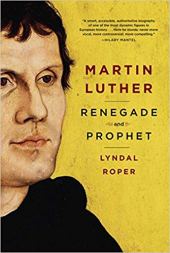 The last few years have witnessed an upsurge in the publication of titles related to the era of the Protestant Reformation, thanks in large part to the Reformation’s 500th anniversary last year. Out of all these books, I think Lyndal Roper’s Martin Luther: Renegade and Prophet stands a fairly good chance of enduring as a significant contribution to the study of Luther’s life and work. Roper’s background as a historian of early modern Europe at Oxford gives her the ability to paint a textured portrait of Luther’s world. In the pages of this book, Luther comes across as a gregarious, intelligent, passionate, as well as deeply flawed individual. Roper makes it clear for her readers that she wants to neither idolize or denigrate the German Reformer. Rather, she wants to understand the development of his inner world and the nature of his internal contradictions. This was a vivid, in-depth book that successfully avoided being reductive in its portrayal of its subject, which is something one always hopes for in a biography. Continue reading
The last few years have witnessed an upsurge in the publication of titles related to the era of the Protestant Reformation, thanks in large part to the Reformation’s 500th anniversary last year. Out of all these books, I think Lyndal Roper’s Martin Luther: Renegade and Prophet stands a fairly good chance of enduring as a significant contribution to the study of Luther’s life and work. Roper’s background as a historian of early modern Europe at Oxford gives her the ability to paint a textured portrait of Luther’s world. In the pages of this book, Luther comes across as a gregarious, intelligent, passionate, as well as deeply flawed individual. Roper makes it clear for her readers that she wants to neither idolize or denigrate the German Reformer. Rather, she wants to understand the development of his inner world and the nature of his internal contradictions. This was a vivid, in-depth book that successfully avoided being reductive in its portrayal of its subject, which is something one always hopes for in a biography. Continue reading
The Roots of Slaveholder Religion: A Review of “Christian Slavery” by Katharine Gerber
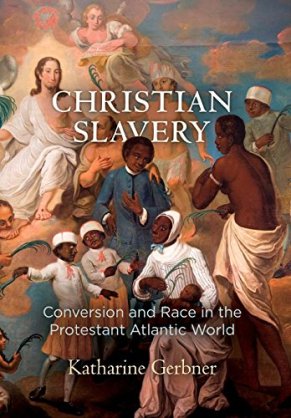 *This review was originally published over at The Englewood Review of Books. If you have a few minutes, please go check out some of their other reviews.
*This review was originally published over at The Englewood Review of Books. If you have a few minutes, please go check out some of their other reviews.
Katharine Gerbner’s Christian Slavery is a meticulously researched, insightful, and at times haunting read—haunting because it feels like the past is always with us. First and foremost, this is an academic work of religious history, but as Gerbner goes into the historical roots of, to use Jonathan Wilson-Hartgrove’s phrase, “slaveholder religion,” the book’s significance doesn’t seem confined to the past. Throughout its pages, Gerbner endeavors to trouble accounts of this historical period that overly-focus on searching for possible early precedents of the 19th century antislavery movement. She argues that it’s significant to acknowledge and recognize that the history of early Protestant missionary efforts unfortunately includes both ideological accommodation to slavery as well as struggle against it (3-4).
In terms of scope, Gerbner spends most of the book’s pages exploring the dynamics of Atlantic Protestantism in the seventeenth and early eighteenth centuries, tracing especially the entanglement of Anglicans, Quakers, and Moravians in the African slave trade (3-4). Near the heart of her subject is an examination of the changing ways in which people in these societies thought about the relationships between Protestant identity, freedom, and slavery. In these societies, Gerbner tells readers, owners were often deeply set against allowing slaves to become Christians and participate in religious rites such as baptism or communion. She explains that this was the case because, “In these colonies, Anglican, Dutch Reformed, and Lutheran slave owners conceived of their Protestant identities as fundamental to their status as masters” (2). This ideology of “Protestant Supremacy,” as she calls it, was undercut by the conversion of African slaves to Christianity. Gerbner suggests how this helped lead to the formation of White Supremacist ideology by noting that: Continue reading
Wesleyan Theology that Yearns for Justice: “A Review of No Religion but Social Religion”
 *This review was originally published over at The Englewood Review of Books. If you have a few minutes, please go check out some of their other reviews.
*This review was originally published over at The Englewood Review of Books. If you have a few minutes, please go check out some of their other reviews.
Liberation theology is often seen largely as a Roman Catholic movement born out of the socioeconomic struggles of the 1960’s and 1970’s in Latin America. There is, of course, much truth in this characterization, though liberation theology’s scope now extends well beyond Latin America when viewed in contemporary global perspective. In his introduction to The Cambridge Companion to Liberation Theology, Christopher Rowland echoes the words of pioneering Peruvian theologian Gustavo Gutiérrez when he points out that part of the significance of liberation theology for the wider Church has been its willingness to take on the challenge of “speaking of God in a world that is inhumane.” And in a world marked by so much suffering and injustice, this is clearly a necessary task.
It isn’t immediately obvious, though, how liberation theology, in all its contemporary diversity, should be related to the Wesleyan theological tradition, which began with the rise of the Methodist movement in 18th century England. Are liberation and Wesleyan theologians kindred spirits? Or do the differing historical roots and concerns of these two movements raise difficulties for those who seek to bring them together? In No Religion but Social Religion, Joerg Rieger, along with Paulo Ayres Mattos, Helmut Renders, and José Carlos de Souza, reflect on this topic with true passion and helpful clarity. In their eyes, these two streams of theology have the potential to draw out the best in each other as they speak of God’s presence among those experiencing poverty in a world marked by both grace and persistent injustice (5-7). They also seek throughout the book to highlight Methodist voices around the world working out of the liberation tradition to demonstrate that liberation theology has roots beyond the world of Roman Catholicism. Continue reading
Encountering Luke’s Portrait of Jesus: A Review of John T. Carroll’s Commentary on the Third Gospel
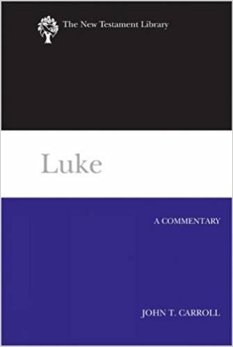 “Luke,” Richard Hays remarks in one of his books, “is above all a storyteller” (2016, 275). This characterization, brief as it is, highlights what might be the most important dimension of the lens that Union Presbyterian Seminary professor John T. Carroll brings to the table in his book, Luke: A Commentary, which was published in 2012.
“Luke,” Richard Hays remarks in one of his books, “is above all a storyteller” (2016, 275). This characterization, brief as it is, highlights what might be the most important dimension of the lens that Union Presbyterian Seminary professor John T. Carroll brings to the table in his book, Luke: A Commentary, which was published in 2012.
A number of New Testament scholars—maybe most prominent among them James Dunn—have highlighted the importance of remembering that the materials we read in the Gospels were in all likelihood first passed on as oral traditions by the earliest communities of Jesus followers. This insight is important at the very least because it prevents contemporary readers from making anachronistic assumptions about how the canonical Gospel texts were formed, but it doesn’t take away from the fruits that can be gathered by also exploring their literary shape and texture. Recognizing the predominantly oral origins of the Gospels and studying the narrative dynamics of their final forms aren’t mutually exclusive tasks. After all, the Gospel writers, in their own distinctive ways, were creative theologians in their own right, not merely haphazard compilers of community traditions.
This gives us one helpful way of framing how Carroll’s commentary fits into the ongoing stream of scholarship on Luke: while some commentaries devote most of their pages to reconstructing the historical world behind the text, and others delve most deeply into the twists and turns of interpretation history that have developed in front of the text, Carroll focuses his critical efforts on narrative analysis on the nuances of meaning in the text itself (9). Continue reading
Tracing the Reformation’s Unintended Legacy: A Review of “Rebel in the Ranks” by Brad S. Gregory
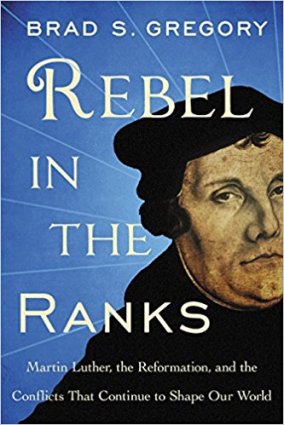 *This review was originally published over at The Englewood Review of Books. If you have a few minutes, please go check out some of their other reviews.
*This review was originally published over at The Englewood Review of Books. If you have a few minutes, please go check out some of their other reviews.
It’s now been five hundred years since Martin Luther sparked off the Protestant Reformation with the publication of his Ninety-Five Theses. Whether or not he actually pinned them to a church door in Wittenberg or just sent them to Archbishop Albrecht, the ensuing movement of reform and protest against aspects of Roman Catholic practices and beliefs that began with him ultimately shook the foundations of the Western church and led to both religious renewal—for both Protestants and Catholics—and sadly also centuries of strife, division, and bloodshed. To say the least, the legacy of the Reformation era that we’ve inherited is a complicated one.
In Rebel in the Ranks, University of Notre Dame professor Brad S. Gregory argues that this legacy was also for the most part unintended. He thinks many of the long-term outcomes of the Reformation would have surprised and even dismayed the Reformers themselves (1-2). The book begins with a rather narrow focus, exploring Luther’s inner religious struggles and what happened when he acted on them. By the end, though, the book’s horizon has expanded to a consideration of how the Reformation era as a whole shaped the emergence of modern Western society, focusing specifically on the eventual secularization of public life (13-14). Continue reading
Election and Reversal in Genesis and Romans: Exploring Robert B. Foster’s “Renaming Abraham’s Children”
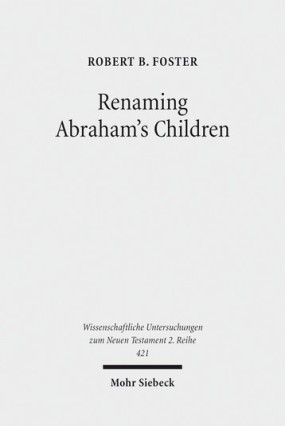 Paul’s Letter to the Romans deals with themes central to the Christian faith, which helps explain why, even after being read and reflected upon for nearly two millennia, lively conversations about how to best interpret it continue to take place. In his dissertation on Romans 9, Renaming Abraham’s Children, Robert B. Foster joins the time-honored tradition of “trying to think Paul’s thoughts after him,” to borrow N.T Wright’s turn of phrase (2009, p.x), attempting to show how Paul’s understanding of election was shaped by his prior engagement with the foundational stories of the patriarchs in Genesis (pp. 1-2). By tracing Paul’s interpretation of these narratives, Foster aims to help uncover a level of theological coherence in chapters 9-11 more frequently sought after than actually found (p.3).
Paul’s Letter to the Romans deals with themes central to the Christian faith, which helps explain why, even after being read and reflected upon for nearly two millennia, lively conversations about how to best interpret it continue to take place. In his dissertation on Romans 9, Renaming Abraham’s Children, Robert B. Foster joins the time-honored tradition of “trying to think Paul’s thoughts after him,” to borrow N.T Wright’s turn of phrase (2009, p.x), attempting to show how Paul’s understanding of election was shaped by his prior engagement with the foundational stories of the patriarchs in Genesis (pp. 1-2). By tracing Paul’s interpretation of these narratives, Foster aims to help uncover a level of theological coherence in chapters 9-11 more frequently sought after than actually found (p.3).
The attention Foster gives to Paul’s usage of the Abrahamic narratives places him within a larger school of thought in scholarship, represented by figures like Richard B. Hays and N.T. Wright. These writers emphasize the idea that many of the more puzzling elements in Paul’s letters can be clarified when viewed as being undergirded by a deeper narrative-driven substructure (for an interesting set of essays examining this trend, see Narrative Dynamics in Paul, edited by Bruce Longenecker). Narrative approaches to Paul are often insightful, but they are sometimes criticized for being too subjective, unable to adequately deal with questions like, “when is a passage’s narrative substructure deftly submerged below the surface, and when is it just not there?” To make his proposal compelling, Foster has to show that he isn’t deaf to these concerns in Renaming Paul’s Children. Continue reading
